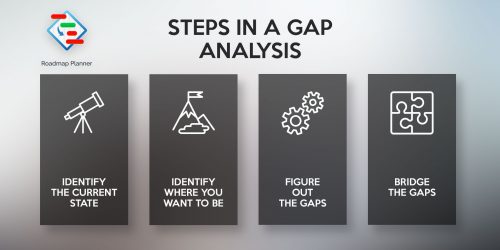
Gap Analysis: Examine & Bridge Gaps to Keep Track of Your Goals
Reading Time: 5 minutesUpdated on Feb. 07, 2020: We’ve stopped support of Roadmap Planner but the Roadmap feature is now available in our new goal-oriented platform – Goals by KeepSolid. This business solution provides the same opportunities to plan and execute your strategies and even more. Check out Goals by KeepSolid and stay tuned for its updates!
Your business is falling behind the set goals? Time to perform gap analysis and identify why your company is not living up to its potential! Read on and find out what is gap analysis and why it is useful for your business.
What is gap analysis
Gap analysis is the process that involves comparing your current performance or progress with what you expected to achieve. The main questions a gap analysis should answer are:
- Where is your business now?
- Where do you wish you were?
- How are you going to close the gap?
Comparing the current and target states, gap analysis helps to identify missing strategies, processes, practices, technologies, or skills and allows to figure out steps to meet your company goals.
Craft a feasible plan with Roadmap Planner to bridge any gaps in your strategy
Gap analysis can also be viewed as a means of comparing performance to potential. Namely, how far a company, team, person, or product fall from their capacity. Gap analysis report identifies areas you need to focus your energy and resources on, as well as shows ways for improvement.
You improve your business efficiency, the product or service you provide, your revenue, all by nailing down and eliminating your company gaps.
How to do a gap analysis
There are different gap analysis methodologies that generally have a very similar approach. In this piece, we’ll present the gap analysis process that consists of 4 steps:

1. Identify the current state
First and foremost, you need to decide on the area you want to analyze and improve. Highlighting the key spheres helps to avoid scope creep and keeps you focused on what matters most.
Then, taking into account the chosen area, identify your current standing. The analysis may include qualitative information, like business processes and methodologies, as well as quantitative information. The latter doesn’t necessarily have to be financial, but also the amount of traffic to your website, the number of phone calls, etc.
The more aspects you analyze and the more data you gather, the higher the chance to grasp the big picture of your current state.
2. Identify where you want to be

After you’ve figured out your current position and have the understanding of how your organization functions, it’s time to get a bit idealistic.
Where would you like your business to be? What prevents you from getting there now? What needs to happen to help you achieve your targets? These are some of the questions you need to answer at this stage of your gap analysis.
3. Figure out the gaps
Now you know your current position and where you wish to be. The “distance” between these two points is the very gap you need to bridge to succeed. This is where you dig deeper and figure out the root causes of this gap.
Ask yourself the following questions:
- What actions and decisions caused your current position?
- Why did the gap happen?
- What could be done differently?
- What resources are required to achieve your goals?
4. Bridge the gaps

At this stage you need to develop a thorough plan to overcome all existing difficulties and close the gap. Come up with solutions and consider the cost of their implementation, taking into account your available resources. All things considered, set a realistic timeframe for closing the gap. And, it’s important, do not focus on too many gaps at a time.
When your plan is outlined, make sure to stick to it and monitor the progress along the way. You could do intermediary follow ups using that same gap analysis technique.
Gap analysis tools and frameworks
There is a number of tools to help you identify the gaps between the current state of your business projects and the future objectives. In other words, these tools and frameworks can be used in different stages of your gap analysis.
Apply them to conduct a more thorough analysis, as well as to work out more accurate tactics to close the gaps found.
- SWOT analysis. SWOT stands for Strengths, Weaknesses, Opportunities and Threats. Using the SWOT methodology, you can determine and effectively combat internal and external threats to your project.
- PEST analysis. PEST is an acronym for Political, Economic, Social, and Technological forces. It presents a good framework of macro-environmental factors which cannot be disregarded.
- Fishbone diagram. This method is also known as cause and effect diagram or Ishikawa diagram. It is a helpful framework to identify the root cause of an issue or effect.
- McKinsey 7-S framework. The framework measures effectiveness of an organization focusing on 7 internal factors: structure, strategy, systems, skills, style, staff, and shared values. It can be used to boost performance, examine effects of future changes, and how to implement the proposed strategy.

How to turn gap analysis into action plan
Gap analysis is a powerful tool to boost productivity and achieve company goals by identifying areas for improvements.
Let’s suppose you’ve conducted a thorough examination and outlined some course of action to take. What next? Make sure to develop a good action plan. For this, use a professional planning tool like Roadmap Planner.
Gap analysis and Roadmap Planner
These here are the Roadmap Planner features that can help you with bridging the gaps and achieving your strategic goals:
- Make your plans visual, and with it, more understandable and achievable.
- Add milestones to help you monitor achievements and make sure you’re on the right track.
- Share your roadmap with all managers and employees, so that everyone is on the same page and sticks to the right course of action.
- Create teams, add and assign tasks and see how you are progressing.
- Use the presentation feature to showcase your strategic roadmap to stakeholders and investors.
- And many more… see the full list here!

Bottom line on gap analysis
Examining the current and desired states, gap analysis allows to figure out the weak points, highlight what was left uncovered, show areas for improvement, and much more.
You significantly boost your chances of success using this technology. Roadmap for gap analysis, in turn, is a good way to convert your analysis results and insights into a powerful action plan. Employ Roadmap Planner and develop a well-thought-out plan to bridge any gap!